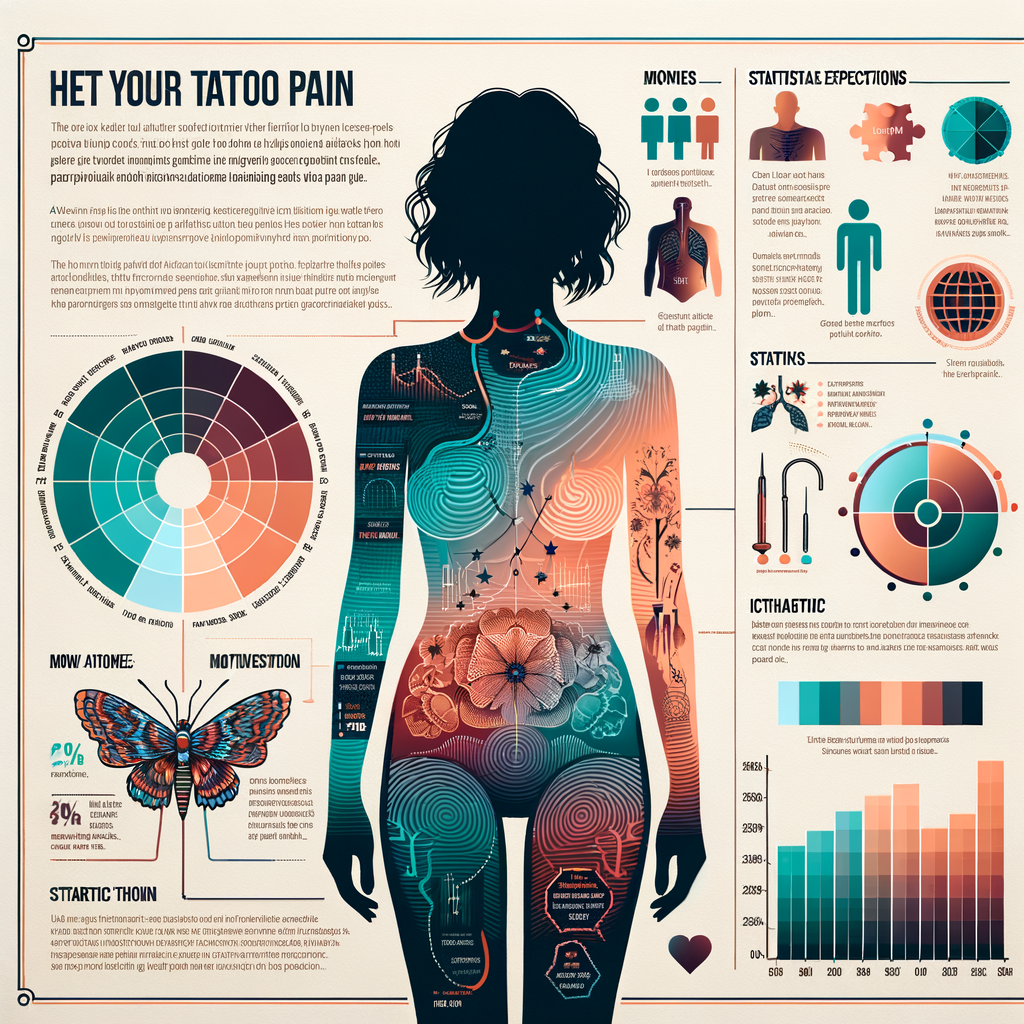
Introduction to Tattoo Pain
Getting a tattoo is a unique experience that involves both excitement and a bit of discomfort. The level of discomfort, often referred to as tattoo pain, varies from person to person. In this section, we will explore the concept of tattoo pain and the factors that influence its intensity.
-
- Understanding the concept of tattoo pain
Tattoo pain is the discomfort felt when a tattoo needle penetrates the skin to deposit ink. It’s a sensation that can be described as a continuous prick or a mild burn. However, it’s important to note that everyone’s pain threshold is different. What might be a slight discomfort for one person could be quite painful for another.
-
- Factors influencing tattoo pain level
Several factors can influence the level of pain experienced during a tattoo session. These include:
-
- Tattoo Location: Some areas of the body are more sensitive than others due to the presence of more nerve endings or less fat padding. For instance, tattoos on the ribs or feet can be more painful than those on the arms or thighs.
- Artist’s Technique: The skill and technique of the tattoo artist can also impact the pain level. Experienced artists can minimize discomfort by applying the right amount of pressure and speed.
- Individual Pain Threshold: As mentioned earlier, everyone’s pain tolerance is different. Factors such as age, gender, and overall health can influence how much pain a person can tolerate.
In the following sections, we will delve deeper into these factors and provide a comprehensive guide on managing tattoo pain. Remember, understanding and preparing for the pain can make your tattoo experience much more enjoyable.
Tattoo Pain Guide
When considering a tattoo, it’s important to understand the pain involved. This guide will help you understand the tattoo pain scale and how to use it.
Understanding the Tattoo Pain Scale
The tattoo pain scale is a tool that helps individuals understand the level of discomfort they might experience during the tattooing process. It ranges from 1 to 10, with 1 being minimal discomfort and 10 being the most intense pain.
-
- Explanation of the tattoo pain scale
The tattoo pain scale is a subjective measure of pain. It’s important to remember that everyone’s pain tolerance is different. What might be a 3 on the scale for one person could be a 6 for another. The scale is meant to provide a general idea of what to expect.
-
- How to use the tattoo pain scale
Before getting a tattoo, it can be helpful to look at the pain scale and consider where you think you might fall on it. This can help you prepare mentally for the experience. During the tattoo process, you can use the scale to communicate with your tattoo artist about how you’re feeling.
In conclusion, understanding the tattoo pain scale can help you prepare for your tattoo experience. It’s a tool that can help you communicate your comfort level with your tattoo artist, ensuring a more positive experience.
Expectations for Tattoo Pain
When it comes to getting a tattoo, it’s crucial to set realistic expectations about the pain involved. The experience is different for everyone, and various factors can influence how much it hurts. Let’s delve into these aspects.
-
- Setting realistic expectations for tattoo pain
Firstly, it’s important to understand that getting a tattoo involves a needle piercing your skin repeatedly. This process can cause discomfort and, in some cases, pain. However, the level of pain varies from person to person and depends on factors like the location of the tattoo, the size and complexity of the design, and individual pain tolerance.
It’s also worth noting that the pain is not constant. Many people describe it as a cycle of discomfort that peaks and then subsides. The initial sting is often the most intense, but your body adjusts to the sensation over time.
Remember, it’s okay to take breaks during the tattooing process if the pain becomes too much. A professional tattoo artist will understand and accommodate your needs.
-
- Case study: First-time tattoo experiences
Let’s consider a case study to better understand what to expect. Jane, a first-time tattoo recipient, shared her experience. She described the pain as a “sharp scratch,” similar to a cat scratch, but not unbearable. She was nervous at first, but her tattoo artist was patient and took breaks when needed. By setting realistic expectations and preparing herself mentally, Jane found the experience manageable and even enjoyable.
Another first-timer, Tom, had a different experience. He described the pain as more intense, like a “burning sensation.” However, he also noted that the pain subsided after a while, and he was able to tolerate it. His advice for others is to choose a small design for their first tattoo and to pick a less sensitive area of the body.
These experiences show that while getting a tattoo can be uncomfortable, it’s not typically unbearable. The key is to set realistic expectations, prepare yourself mentally, and communicate openly with your tattoo artist.
In conclusion, getting a tattoo is a unique experience that comes with its share of discomfort. However, by setting realistic expectations and understanding that the pain is manageable, you can make the process smoother and more enjoyable.
Painful Tattoo Locations
Getting a tattoo is a unique experience that involves both excitement and a bit of discomfort. The level of pain you’ll experience during the tattooing process can vary greatly depending on the location of the tattoo. Let’s delve into the top five most painful spots for tattoos.
Top 5 Most Painful Spots for Tattoos
-
- Detailing the Most Painful Tattoo Locations
1. Ribs: The rib cage is one of the most painful places to get a tattoo because of the thin layer of skin covering the bones. It’s a sensitive area with many nerve endings.
2. Feet: The feet, especially the top and sides, are extremely sensitive due to the multitude of nerves and bones present.
3. Elbows and Knees: These areas have very little fat padding, making the skin here very close to the bone. This can make the tattooing process quite painful.
4. Spine: The spine is another area where the skin is close to the bone, making it a painful spot for a tattoo.
5. Inner Bicep: The skin on the inner bicep is thin and sensitive, making it a painful area for tattooing.
-
- Personal Experiences: Painful Spots for Tattoos
Many tattoo enthusiasts have shared their experiences about getting tattoos in these painful areas. One common sentiment is that the pain, while intense, is temporary and manageable. For example, Jane, a tattoo enthusiast, shared her experience of getting a rib tattoo. She mentioned that while the pain was intense, it was bearable and the end result was worth it.
Another tattoo lover, John, got a tattoo on his spine. He described the pain as a sharp, constant prickling sensation. However, he also emphasized that the pain was a part of the experience and he was thrilled with his tattoo.
Remember, everyone’s pain tolerance is different. What might be extremely painful for one person might be less so for another. It’s important to be prepared and know what to expect when choosing the location for your tattoo.
Areas for Less Painful Tattoos
While it’s true that getting a tattoo involves some level of discomfort, certain areas of the body are less painful to tattoo than others. Let’s explore these less painful spots and understand why they are considered as such.
- Identifying less painful spots for tattoos
When it comes to getting a tattoo, the level of pain you might experience can vary depending on where you choose to get inked. Some areas are less sensitive due to thicker skin or fewer nerve endings. Here are some of the less painful spots for tattoos:
| Area | Reason |
|---|---|
| Outer Bicep | Thicker skin, fewer nerve endings |
| Thigh | More muscle, less nerve density |
| Calves | More muscle, less nerve density |
| Buttocks | More fat, fewer nerve endings |
- Why these areas are less painful
The reason why these areas are less painful is due to the structure of our skin and the distribution of nerve endings. The outer bicep, for example, has thicker skin and fewer nerve endings, which means it’s less sensitive to the needle’s pricks. Similarly, areas like the thighs and calves have more muscle mass and less nerve density, making them less sensitive to pain. The buttocks, on the other hand, have a higher fat content and fewer nerve endings, which also reduces the pain sensation.
In conclusion, while getting a tattoo will always involve some discomfort, choosing one of these less painful spots can make the experience more bearable. Remember, everyone’s pain tolerance is different, so what might be less painful for one person could be more painful for another. It’s always best to discuss your options with a professional tattoo artist before making a decision.
Managing Tattoo Pain
Getting a tattoo involves a certain level of discomfort, but with the right preparation and strategies, you can manage the pain effectively. Let’s delve into how you can prepare for tattoo pain and the strategies you can use to manage it.
Tattoo Pain Preparation
-
How to Prepare for Tattoo Pain
Preparation is key when it comes to managing tattoo pain. Here are some steps you can take:
- Stay Hydrated: Drinking plenty of water before your tattoo session can help your skin stay resilient and healthy, making the tattooing process less painful.
- Eat a Good Meal: Eating a substantial meal before your session can help maintain your blood sugar levels, reducing the risk of feeling faint or dizzy during the process.
- Get Plenty of Rest: Being well-rested can help your body better cope with the stress and discomfort of getting a tattoo.
-
Effective Strategies for Managing Tattoo Pain
Once you’re in the tattoo chair, there are several strategies you can use to manage the pain:
- Deep Breathing: Deep, slow breathing can help calm your body and mind, reducing the perception of pain.
- Distract Yourself: Listening to music, watching a movie, or engaging in conversation can help distract you from the pain.
- Take Breaks: If the pain becomes too intense, don’t hesitate to ask your tattoo artist for a short break.
Remember, everyone’s pain tolerance is different. What works for one person may not work for another. The key is to find what works best for you and to communicate openly with your tattoo artist about your comfort level.
Post-Tattoo Pain Management
After getting a tattoo, it’s normal to experience some level of discomfort. However, there are ways to manage this pain effectively. Let’s explore some of the best practices.
-
- How to manage pain after getting a tattoo
Firstly, it’s important to remember that everyone’s pain tolerance is different. What may be a minor annoyance for one person could be more painful for another. However, there are common strategies that can help manage post-tattoo pain.
Over-the-counter pain relievers can be a great help. Non-prescription drugs like ibuprofen or acetaminophen can reduce inflammation and lessen the pain. However, avoid aspirin as it can increase bleeding.
Applying a cold compress to the tattooed area can also provide relief. The cold helps to numb the skin and reduce inflammation. However, make sure to wrap the compress in a clean cloth before applying it to your skin to avoid infection.
Rest is also crucial. Your body needs energy to heal, and getting plenty of sleep can help speed up this process.
-
- Importance of aftercare in pain management
Proper aftercare is key to managing pain and ensuring your tattoo heals properly. Aftercare starts as soon as your tattoo is done. Your tattoo artist will likely cover your tattoo with a bandage or plastic wrap to protect it from bacteria and other contaminants.
After a few hours, you can remove the bandage and gently clean the tattoo with warm water and mild soap. Avoid scrubbing the area and pat it dry with a clean towel. Then, apply a thin layer of a recommended ointment or lotion.
It’s also important to keep your tattoo moisturized and protected from the sun. Dry skin can lead to itching and discomfort, while sun exposure can cause your tattoo to fade.
Remember, a tattoo is a wound. Treat it with care, and if you notice any signs of infection such as excessive redness, swelling, or pus, consult a healthcare professional immediately.
Conclusion: Embracing the Tattoo Experience
As we conclude, it’s important to remember that getting a tattoo is a unique and personal journey. It’s not just about the end result, but also the experience itself. Let’s summarize the key takeaways and share some final thoughts on managing tattoo pain.
-
- Summary of Key Takeaways
Firstly, understanding tattoo pain is crucial. Everyone experiences pain differently, and the level of discomfort can vary depending on the tattoo’s location. We’ve learned that areas with thinner skin or closer to bones tend to be more sensitive.
Secondly, we’ve explored various methods to manage tattoo pain. These include mental preparation, using numbing creams, and maintaining a healthy lifestyle before your appointment. Remember, it’s essential to communicate with your tattoo artist about your pain tolerance.
Lastly, we’ve discovered that the tattoo experience is more than just enduring pain. It’s about expressing your individuality and embracing the journey.
-
- Final Thoughts on Managing Tattoo Pain
Managing tattoo pain is a significant part of the tattoo experience. It’s not something to fear, but rather, it’s something to prepare for. Pain is temporary, but the art you carry with you is permanent.
Remember, the pain of getting a tattoo is a small price to pay for a piece of art that you’ll carry with you forever. Embrace the experience, manage the pain, and enjoy the journey of self-expression.
In the words of a famous tattoo artist, “The pain is part of the process, it’s part of the art. It’s worth it.”






